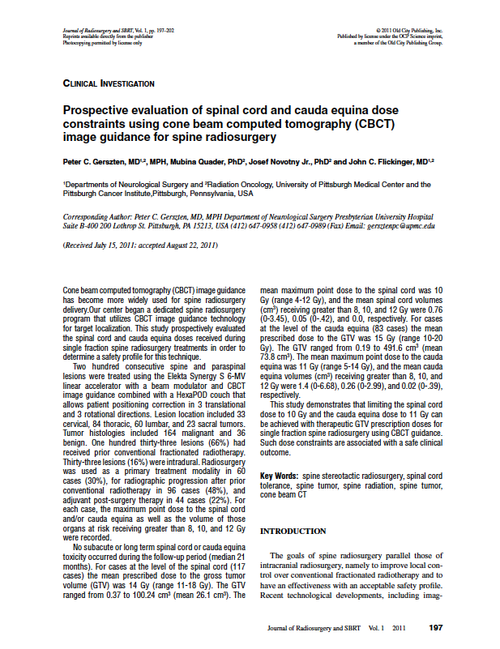- Home
- Journal Contents Downloads
- JRSBRT Downloads
- JRSBRT 1.3, p. 197-202
Product Description
Prospective evaluation of spinal cord and cauda equina dose constraints using cone beam computed tomography (cbct) image guidance for spine radiosurgery
Peter C. Gerszten, MPH, Mubina Quader, Josef Novotny Jr., John C Flickinger
Cone beam computed tomography (CBCT) image guidance has become more widely used for spine radiosurgery delivery.Our center began a dedicated spine radiosurgery program that utilizes CBCT image guidance technology for target localization. This study prospectively evaluated the spinal cord and cauda equina doses received during single fraction spine radiosurgery treatments in order to determine a safety profile for this technique.
Two hundred consecutive spine and paraspinal lesions were treated using the Elekta Synergy S 6-MV linear accelerator with a beam modulator and CBCT image guidance combined with a HexaPOD couch that allows patient positioning correction in 3 translational and 3 rotational directions. Lesion location included 33 cervical, 84 thoracic, 60 lumbar, and 23 sacral tumors. Tumor histologies included 164 malignant and 36 benign. One hundred thirty-three lesions (66%) had received prior conventional fractionated radiotherapy. Thirty-three lesions (16%) were intradural. Radiosurgery was used as a primary treatment modality in 60 cases (30%), for radiographic progression after prior conventional radiotherapy in 96 cases (48%), and adjuvant post-surgery therapy in 44 cases (22%). For each case, the maximum point dose to the spinal cord and/or cauda equina as well as the volume of those organs at risk receiving greater than 8, 10, and 12 Gy were recorded.
No subacute or long term spinal cord or cauda equina toxicity occurred during the follow-up period (median 21 months). For cases at the level of the spinal cord (117 cases) the mean prescribed dose to the gross tumor volume (GTV) was 14 Gy (range 11-18 Gy). The GTV ranged from 0.37 to 100.24 cm3 (mean 26.1 cm3). The mean maximum point dose to the spinal cord was 10 Gy (range 4-12 Gy), and the mean spinal cord volumes (cm3) receiving greater than 8, 10, and 12 Gy were 0.76 (0-3.45), 0.05 (0-.42), and 0.0, respectively. For cases at the level of the cauda equina (83 cases) the mean prescribed dose to the GTV was 15 Gy (range 10-20 Gy). The GTV ranged from 0.19 to 491.6 cm3 (mean 73.8 cm3). The mean maximum point dose to the cauda equina was 11 Gy (range 5-14 Gy), and the mean cauda equina volumes (cm3) receiving greater than 8, 10, and 12 Gy were 1.4 (0-6.68), 0.26 (0-2.99), and 0.02 (0-.39), respectively.
This study demonstrates that limiting the spinal cord dose to 10 Gy and the cauda equina dose to 11 Gy can be achieved with therapeutic GTV prescription doses for single fraction spine radiosurgery using CBCT guidance. Such dose constraints are associated with a safe clinical outcome.
Keywords: spine stereotactic radiosurgery, spinal cord tolerance, spine tumor, spine radiation, spine tumor, cone beam CT
After payment has been processed for your order of a digital copy (PDF) of this article, you will see a download link on your completed order page and also receive an email containing a download link. The links, which will enable you to download one copy of the article, will expire after 24 hours.
 Loading... Please wait...
Loading... Please wait...



